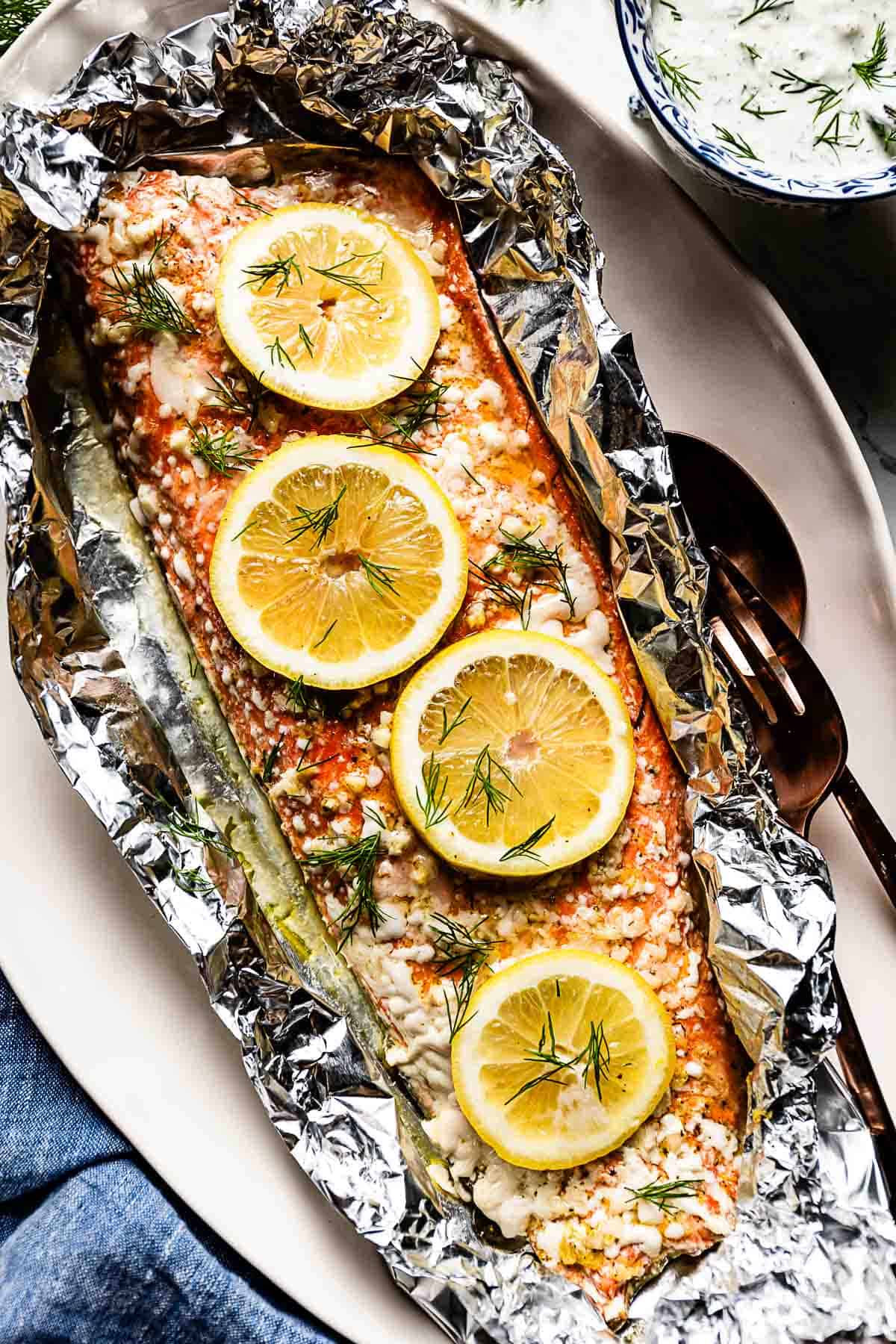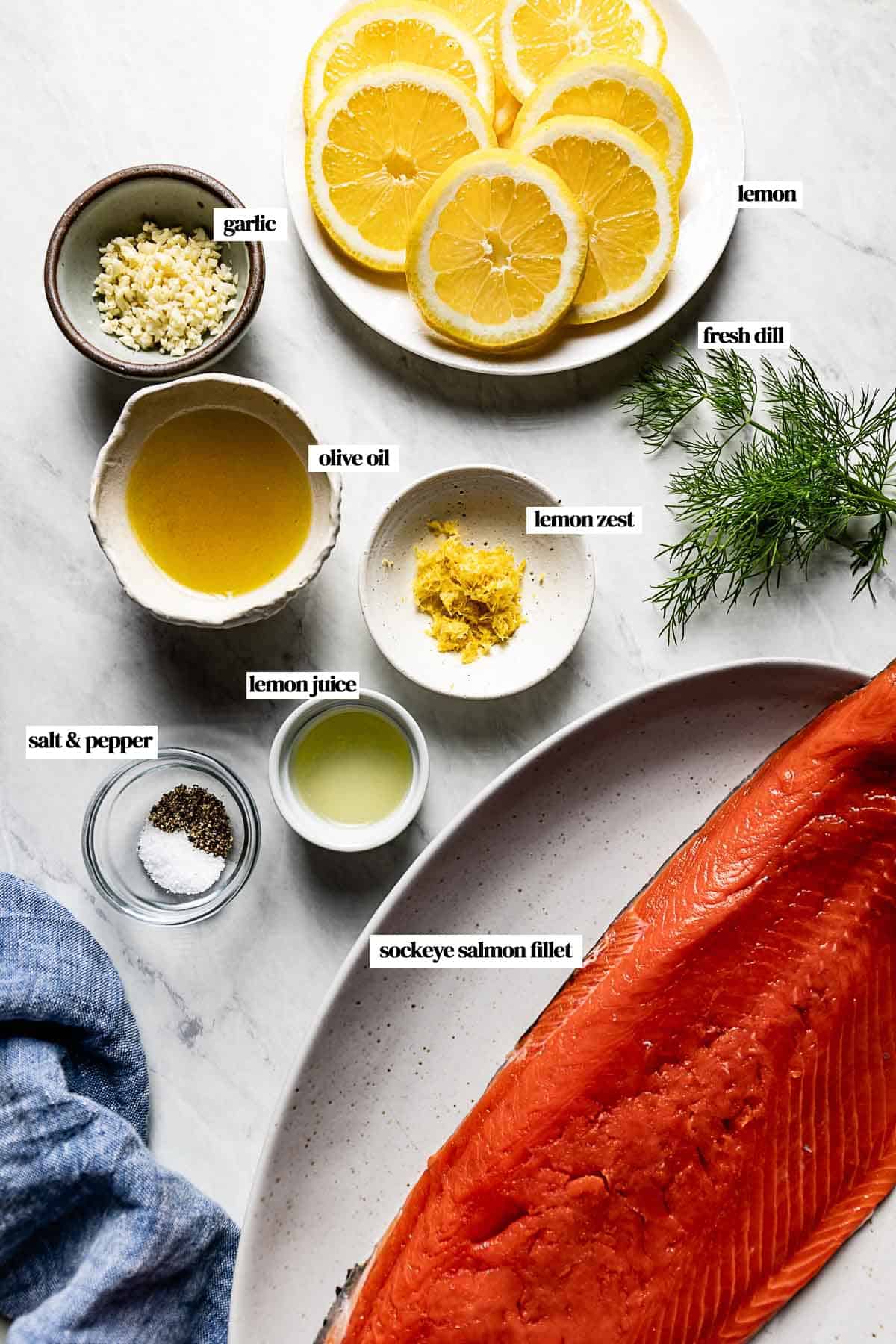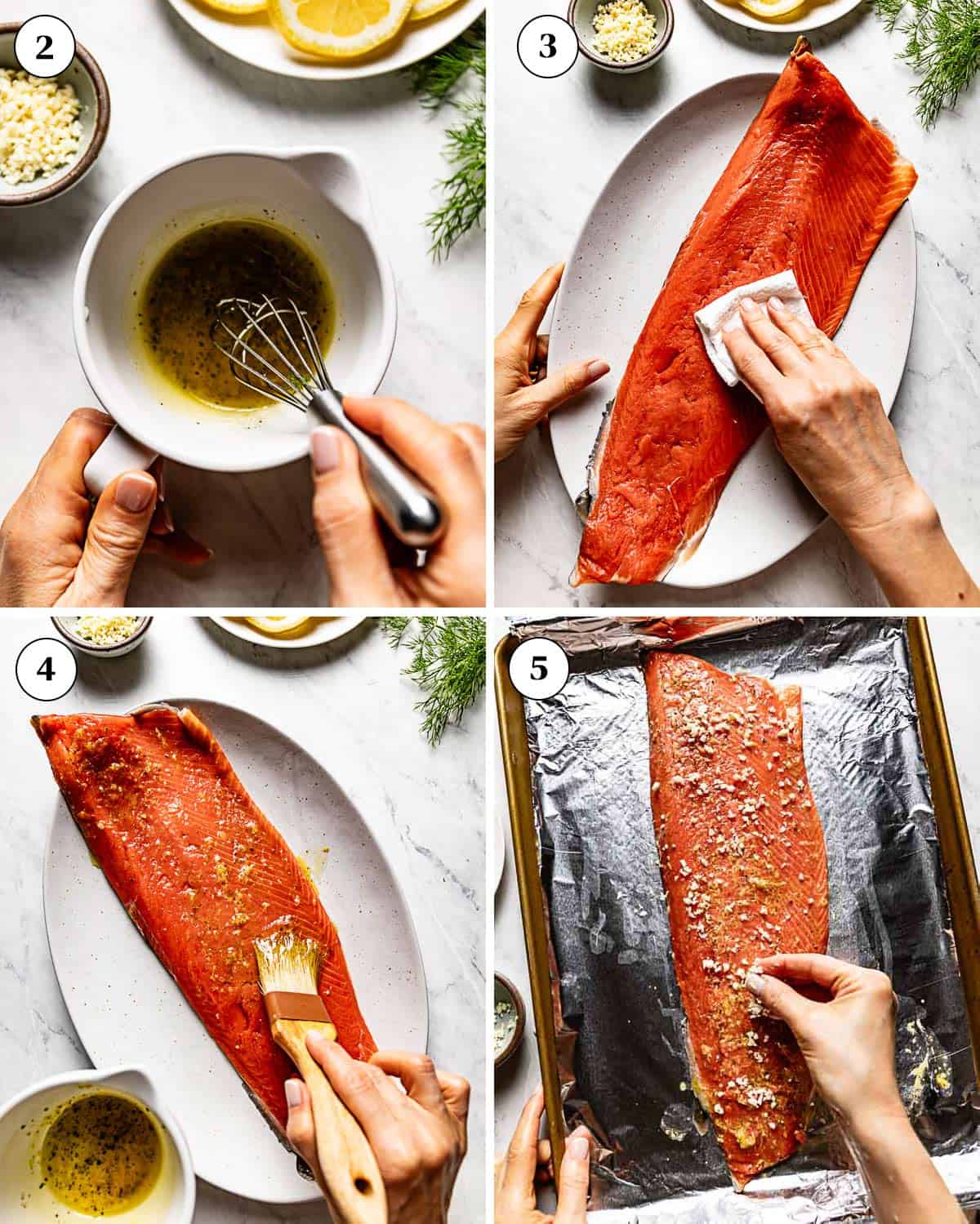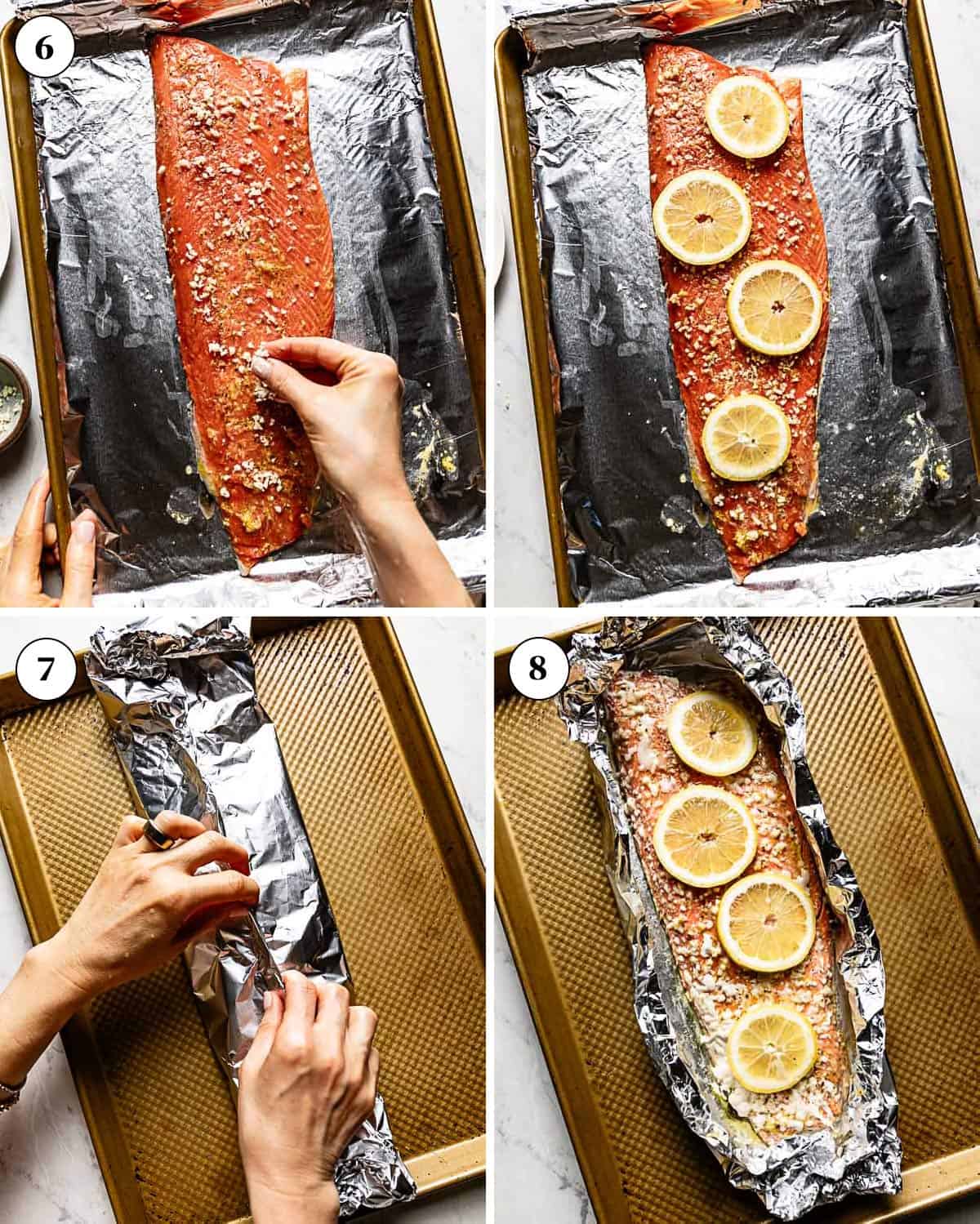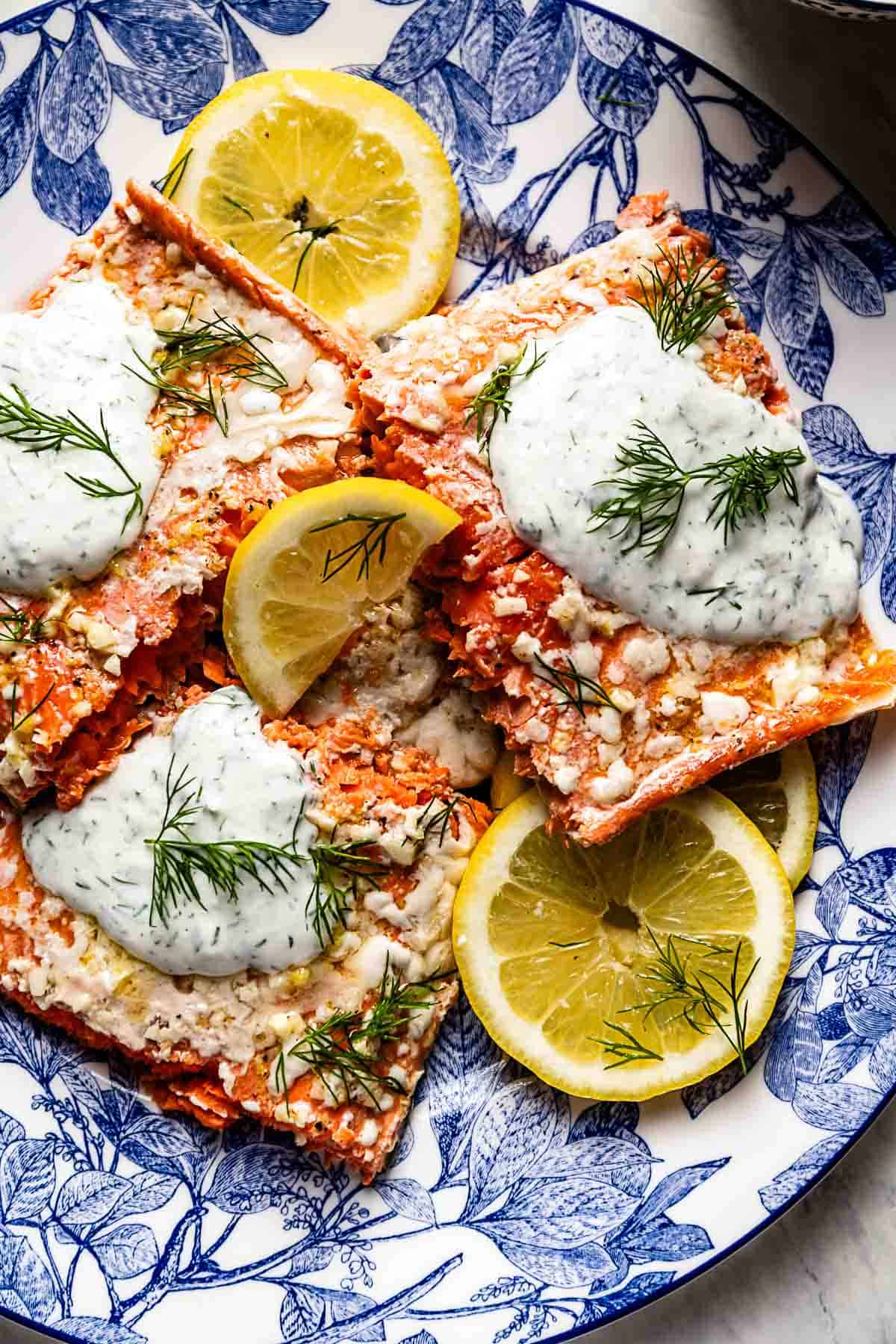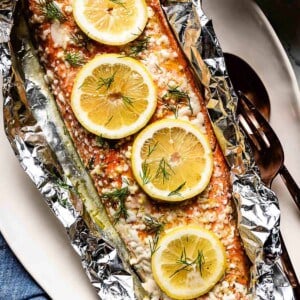For the fish:
Wild Alaskan Sockeye Salmon (Fresh or Frozen): Using high-quality fish is essential to give this recipe its rich, buttery flavor. We used fresh salmon, which is in season from May through July. I also prefer using a whole salmon filet with the skin on it for easy cooking and a beautiful presentation. However, you can also use pre-cut fillets for a perfectly portioned spread. If you use frozen sockeye salmon fillets, thoroughly thaw them before roasting them.
Seasoning: The best seasoning for sockeye salmon includes a basic mixture of zesty, robust ingredients and fresh herbs. Because this mixture packs so much flavor, you don’t need much to give your fish an incomparably bold taste.
Olive oil: Olive oil ensures that this oven-baked sockeye salmon recipe develops a crisp exterior and succulent, tender flesh while cooking. However, avocado oil will also work as a substitute. Lemon: To give this dish bright flavors and an immaculate presentation, you’ll need fresh lemon juice, zest, and slices. Seasonings: Only kosher salt and freshly ground black pepper are necessary to season this baked salmon recipe. You can also sprinkle it with a pinch of red pepper flakes if you prefer. Fresh garlic cloves: Finely minced garlic is the best but you can use garlic powder in a pinch. Fresh herbs: Fresh dill and parsley are two signature herbs for red salmon recipes, lending them citrusy notes and grassy undertones. You can add one, the other, or both herbs for an elaborate flavor profile.
Have more questions about this tasty oven-baked fish? We’ve got you covered, whether you’re wondering where wild salmon fillet comes from or expert seasoning tips.
Good quality fish: The best way to cook sockeye salmon is by starting with good-quality fish fillets. If you buy fresh fish, cooking it within the first 24-48 hours is ideal for maximum flavor. If you prefer using packaged, pre-cut frozen fillets, thaw them fully before roasting. The best way to thaw frozen fish is by placing it in the fridge overnight. The temperature of your oven: We tested this recipe at various temperatures, including 375, 400, and 425 degrees F. However, we found that a gentle, low-temperature oven—ideally, 375 degrees F. for 10 minutes (until it is medium-rare) —produced the most tender, moist salmon. The thickness of the fish: Sockeye salmon tends to be thinner than Atlantic salmon, which will affect your ideal cooking time. Therefore, if you’re working with a thicker fillet, I recommend increasing its time in the oven by a few minutes and vice versa. Check doneness: Your sockeye salmon temperature should reach 120-125 degrees F. before removing the fish from the oven. Keep in mind that it will continue to cook after you take it out of the oven because of the residual heat. If you do not have a thermometer to check doneness, you can also tell by looking at its texture and color. Fully cooked salmon should have a flaky texture and an opaque pink color before removing it from the oven. Finally, you can do the fork test. If it flakes easily it should be ready to enjoy. Slightly undercook it: When baking sockeye salmon in the oven, it’s important to slightly undercook your fish and let it rest for a few minutes before serving. The fillets will continue to cook even while resting, giving them time to reabsorb their juices and keep them from becoming dry. In short, undercooking the fish will provide you with a moist sockeye salmon recipe no one can resist. Use the skin as a barrier to avoid overcooking: For best results, I highly recommend keeping the skin on your salmon fillet while baking (even if you are not a fan of eating the skin.) It comes off easily after the roasting process and acts as a protective fatty barrier on the fillets’ bottoms, keeping the fish from overcooking. Aluminum foil vs. parchment paper: I prefer to make baked sockeye salmon in foil due to its ability to trap steam and maintain heat, resulting in moist, succulent fish. However, if you prefer parchment paper, simply increase the cooking time by two minutes to ensure thorough roasting. Presentation: If you want your salmon to pop, add colorful and flavorful additions to your garnish ingredients, such as lemon slices and fresh herbs. You can also ensure a beautiful presentation by serving your fillet on a center plate, drizzled with your chosen sauce.
What to Serve With This Recipe?
Alaskan sockeye salmon fillets make an irresistible pair with countless other delectable recipes. All my favorites are in this delicious collection, from flavorful grains to tender roasted veggies.
Sauces and salsas: With its creamy, bright flavors, Yogurt Dill Sauce is one of my favorite sauces to prepare when cooking Alaskan salmon. For a sweeter, more colorful option, you could also top your fillets with Mango Salsa or Peach Salsa—both of which complete this photo-ready spread. Salad: This simple salmon recipe makes a phenomenal combination with any of my bright summertime salads. You can whip up my Spring Mix Salad or Butter Lettuce Salad in under twenty minutes for two of my most colorful, crisp sides. Vegetables: Wild sockeye can pair with nearly any of my tasty vegetable sides because of its extreme versatility. However, some of my favorites include creamy Mexican Street Corn, buttery Roasted Asparagus, and Air-Fried Corn on the Cob. Cooked Grains or Pasta: Nothing makes a more sumptuous pair than baking sockeye salmon in foil alongside a hearty grain dish. I recommend serving up a pot of Cooked Wild Rice or Cooked Quinoa for a well-seasoned, healthy side. You could also compliment your light fish with rich pasta recipes, like Garlic Butter Pasta or Zucchini Lasagna, or add a nutty, herbaceous taste with a bowl of Green Pasta. Wine: The best way to prepare sockeye salmon is alongside a bottle of crisp, dry white wine, such as pinot grigio or sauvignon blanc.
Other Fish Recipes You Might Also Like
If you enjoy this easy sockeye salmon recipe and are a fan of grilled salmon, be sure to try our Grilled Sockeye Salmon recipe as well. And if you are in need of other seafood dinner inspiration, check out these other dishes—from wild Alaskan salmon recipes to mild mahi mahi— to satisfy your seafood fix in a snap.
Storage: To store your salmon steak, let it come to room temperature first. Then, transfer it to an airtight container (or wrap it tightly in tin foil or stretch film), and place it in the refrigerator. Your fillets will stay fresh for 2-3 days. Freeze: Though you can technically freeze cooked sockeye salmon, the fish’s texture and flavor won’t be as good as the freshly roasted version. Therefore, I don’t recommend freezing this recipe once cooked. Reheating: The best part about this dish is that you can enjoy it warm, room temperature, or cold. If you prefer a warm fillet, reheat your fish in a low-heat oven (275-300 degrees F.) for 3-4 minutes or until heated. However, cook your salmon sparingly, as it will become dry and flavorless if overheated.
Smoked Salmon Avocado Toast Breaded Fish Blackened Mahi Mahi Grilled Mahi Mahi
If you try this Wild Alaskan Sockeye Salmon recipe, please take a minute to rate it and leave a comment below. It will be a huge help to others who are thinking of making the recipe. If you take some pictures, be sure to share them on Instagram using #foolproofeats so I can share them in my stories.

